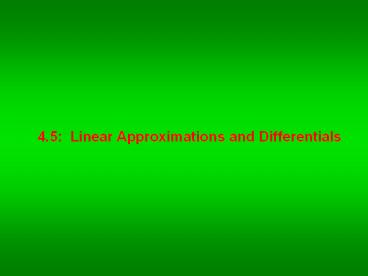Linearization and Differentials - PowerPoint PPT Presentation
Title:
Linearization and Differentials
Description:
4.5: Linear Approximations and Differentials * * Let s start with the function at x = 4 because we know what is Mysterious radiation has caused all calculators ... – PowerPoint PPT presentation
Number of Views:25
Avg rating:3.0/5.0
Title: Linearization and Differentials
1
4.5 Linear Approximations and Differentials
2
Mysterious radiation has caused all calculators
to stop working. It just so happens that at this
time, you need to find out the square root of 5.
The best you are going to be able to do now is
approximate it. But how?
When we make a graph of this process, you will
get a better sense of why we are doing this.
First of all, what is the tangent line at x 4?
Now graph both the function and its tangent line
3
Notice that for numbers close to 4, the tangent
line is very close to the curve itself
So lets try plugging 5 into the tangent line
equation and see what we get
4
Notice how close the point on the line is to the
curve
(5, 2.25)
So lets plug 5 into the tangent line to get
?
?
(4, 2)
?
As it turns out
So in this case, our approximation will be a very
good one as long as we use a number close to 4.
5
For any function f (x), the tangent is a close
approximation of the function for some small
distance from the tangent point.
6
For any function f (x), the tangent is a close
approximation of the function for some small
distance from the tangent point.
? (ah, y(ah))
(a, f(a)) ?
? (ah, f(ah))
Where y mt(x a) f(a)
7
For any function f (x), the tangent is a close
approximation of the function for some small
distance from the tangent point.
? (ah, y(ah))
(a, f(a)) ?
? (ah, f(ah))
We call the equation of this tangent the
linearization of the function at a and it is
denoted by the function notation L(x).
8
Problems in the book will also refer to the
linearization of f at a
y y0 m(x x0)
We take the point-slope form
Make a few notational substitutions
and
Remember The linearization is just the equation
of the tangent line. The use of the term L(x) is
to make it known that you are using the tangent
line to make a linear approximation of the
function in question. But we are still just
talking about the tangent line.
9
Try a few simple linearizations near x 0
The graph would look like this
10
Notice how close the graphs are to each other
near x 0
11
Try a few simple linearizations near zero
Now try the other three.
12
Differentials
Chemistry students should recognize ?y and ?x.
Remember that taking a derivative assumes that
both ?x and ?y go to 0. When we did this
For this method, we are going to allow dx to be a
small number but not 0.
13
Differentials
Note that as long as dx and dy are going to 0,
then we are getting more precise. But as soon as
we start making dx gt 0, then we are going in the
other direction so whatever we get by this method
is an approximation of the change in y
14
For this method, we are going to allow dx to be a
small number but not 0.
In which dy will be a small change in y which we
will determine by multiplying the derivative by
the small change in x (dx).
15
Lets remember what we are trying to accomplish
here.
Since dy approximate change in y,
lets set dx 1
Why choose 1 in this case?
16
Since
Well use the tangent line at x 8 for the
linearization
17
Since
Now lets use differentials
and 9
Same as with linearization
18
A square with sides x has an area
If a 2 X 2 square has its sides increase by 0.1,
use differentials to approximate how much its
area will increase.
19
What will the actual difference in area be?
Actual change in area
So our approximation is off by
Our percentage error here is































